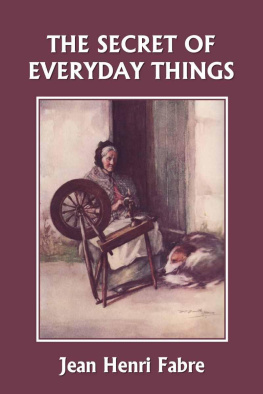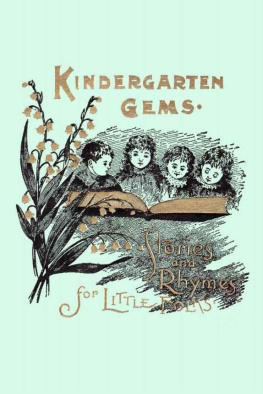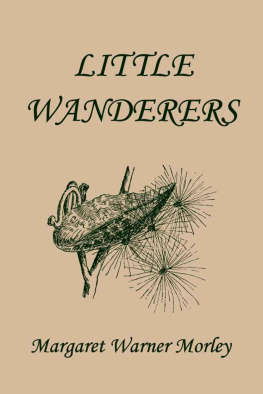The Secret of Everyday Things
by
Jean Henri Fabre
Yesterday's Classics
Chapel Hill, North Carolina
Cover and Arrangement 2010 Yesterday's Classics, LLC
All rights reserved. No part of this book may be reproduced or retransmitted in any form or by any means without the written permission of the publisher.
This edition, first published in 2010 by Yesterday's Classics, an imprint of Yesterday's Classics, LLC, is an unabridged republication of the work originally published by The Century Company in 1920. This title is available in a print edition (ISBN 978-1-59915-252-3).
Yesterday's Classics, LLC
PO Box 3418
Chapel Hill, NC 27515
Yesterday's Classics
Yesterday's Classics republishes classic books for children from the golden age of children's literature, the era from 1880 to 1920. Many of our titles are offered in high-quality paperback editions, with text cast in modern easy-to-read type for today's readers. The illustrations from the original volumes are included except in those few cases where the quality of the original images is too low to make their reproduction feasible. Unless specified otherwise, color illustrations in the original volumes are rendered in black and white in our print editions.
Introductory Note
The clearness, simplicity, and charm of the great French naturalist's style are nowhere better illustrated than in this work, which in its variety of subject-matter and apt use of entertaining anecdote rivals "The Story-Book of Science," already a favorite with his readers. Such instances of antiquated usage or superseded methods as occur in these chapters of popular science easily win our indulgence because of the literary charm and warm human quality investing all that the author has to say.
Translator.
Contents
CHAPTER I
Thread
U NCLE P AUL resumed his talks on things that grow and things that are made, while his nephews, Jules and Emile, and his nieces, Claire and Marie, listened to his "true stories," as they liked to call them, and from time to time asked him a question or put in some word of their own.
Continuing the subject of cotton-manufacture, he called his hearers' attention to the number of processes the raw material must go through before it emerges as finished fabric ready for making into wearing apparel, and to the countless workmen that must, from first to last, have been engaged in its production and in all the operations leading up to its final application to household uses.
"Then I should think," said Marie, "that cotton cloth would be very expensive if all those workmen are to get their pay for the time and labor they have put into its manufacture."
"On the contrary," Uncle Paul assured her, "the price is kept down to a very moderate figure; but to accomplish this surprising result two powerful factors are called into play,wholesale manufacture and the use of machinery. The process employed for spinning cotton into the thread that you see wound on spools will help you to understand my meaning.
"You know how the housewife spins the tow that is used for making linen. First she thrusts inside her belt the distaff, made out of a reed and bearing at its forked end a bunch of tow; then with one hand she draws out the fibers and gathers them together by moistening them a little with her lips, while with the other she twirls her spindle and thus twists the loose fibers into a single strand. After she has twisted it tightly enough she winds it on the spindle, and then proceeds to draw out another length of tow from the distaff."
SPINNING-WHEEL FOR FLAX
"Mother Annette is very skilful with the distaff," put in Claire. "I like to hear her thumb snap when she twirls the spindle. But when she spins wool she uses a spinning wheel."
"First of all," Uncle Paul explained, "the carded wool is divided into long wisps or locks. One of these is brought into contact with a rapidly twirling hook, which catches the wool and twists it into a thread that lengthens little by little at the expense of the lock of wool, the latter being all the while held and controlled by the fingers. When the thread has attained a certain length it is wound on the spindle by a suitable movement of the wheel; and then the twisting of the lock of wool is resumed. In case of need cotton could thus be spun by hand; but, skilful as Mother Annette is at such work, cloth made from thread spun in that fashion would be enormously expensive because of the time spent in producing it. What, then, shall we do? We must resort to machinery, and in vast establishments known as cotton factories we set up hundreds of thousands of spindles and bobbins, all moving with perfect precision and so rapidly that the eye cannot follow them."
"It must be wonderful," remarked Jules, "to see all those machines spinning the cotton into thread so fast you can't keep track of them."
"Yes, those machines surpassing in delicate dexterity the nimble fingers of the most skilful spinner, are indeed among the cleverest inventions ever produced by man; but they are so complicated that the eye gets lost among their innumerable parts. I can only point out to you the more important of these parts, without hoping to mke you understand how the whole machine operates.
SPINNING-WHEEL FOR WOOL
"First there are the cards which comb the mass of cotton into fine strips or ribbons, just as Mother Annette cards the wool she is about to spin on her wheel. These cards of hers, you understand, are nothing more nor less than big brushes bristling with a multitude of fine iron points. One card remains at rest and receives a thin layer of wool, after which the other is made to pass over it in such a way as to comb the wool and draw out fine locks of it, one after another. In this fashion, too, the cards in cotton factories play their part. On leaving the cards the ribbons of cotton fiber are drawn out, lightly twisted, and then wound on bobbins. Next a machine called a spinning-jenny takes the partly spun cotton and twists it into thread more or less fine according to the purpose it is to serve. Finally this thread finds its way automatically to the reel, which forms it into skeins, or to the winder, which winds it into those regular balls that we can't admire too much for their perfect shape. You have doubtless observed with what precision, what elegance, the thread is wound into a ball that the merchant delivers to you at the insignificant price of a few centimes. What human hands would have the steadiness, what fingers the skill to achieve anything comparable with this little masterpiece?"

HARGREAVES' ORIGINAL SPINNING-JENNY
"I know I can't begin to wind such a ball," said Marie; "it just makes a shapeless lump instead of the pretty ball I buy at the store."
"No one, depending only on his hands, could ever achieve that admirable regularity," Uncle Paul assured her. "To that end we must have machines, unvarying in their movements and working with a precision that nothing can derange.
"Thread is numbered according to its degree of fineness, the higher the number the finer the thread. Every skein and every ball being of the same length, its weight increases as the fineness diminishes. We say, then, of a particular thread that it is number 200 when it takes two hundred skeins or balls to make half a kilogram in weight, and that it is number 150 when it takes one hundred and fifty to make up the same weight."
















